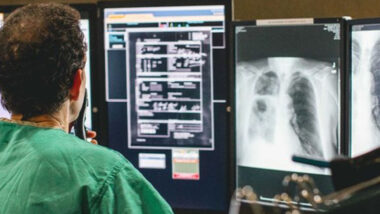For those who feel at home on the green, golf injuries can be par for the course. Whether those injuries are caused by the overuse of specific muscles or improper form, your doctor will use every tool at their disposal to recommend the most effective treatment. In many cases, diagnostic imaging is needed to help identify and then treat the source of your injury, so you can grab your clubs and hit the driving range again in no time.
Common Types of Golf Injuries
Like any sport, golfing puts stress on the body and can lead to a variety of injuries, including:
- Chronic pain: Overuse or overexertion can lead to pain or fatigue in the body, especially in the arms, legs and back. Wrist and knee pain are also common.
- Golfer’s elbow: The repeated motion of swinging a golf club (or using an incorrect grip or club) can gradually cause the tendons on the inside of the elbow to become inflamed. This inflammation can cause pain throughout the elbow and arm.
- Lumbar spine injuries: The back, specifically the lower back (or lumbar spine), is particularly susceptible to injuries. Muscle strains and disk injuries can cause pain and impact mobility.
- Numbness and pain in the palms and hands: When a golf club handle digs into your hand, blood vessels underneath the muscle on the outside of the palm can weaken over time. This can disrupt blood flow to the hand and fingers, causing pain and numbness.
- Rotator cuff injuries: Shoulder pain is prevalent in golfers due to the nature of the golf swing. Rotator cuff injuries, including tears, as well as inflammation of tendons and bursae surrounding tendons, can develop.
- Strains and sprains: Golfing and its repetitive motions can put strain on the tissue between bones and may sprain the muscles around bones.
- Tendinitis: The tendons around joints in the hips, knees, elbows, wrists or shoulders can become inflamed, leading to a condition known as tendinitis.
Read More: Take the Quiz — What Is Your Diagnostic Imaging IQ?
Golf Injuries and Diagnostic Imaging
Whether you have chronic pain or an acute injury, it’s a good idea to visit your doctor if the discomfort is severe or the condition doesn’t get better within several weeks. Your doctor may order diagnostic imaging to determine the full extent of your golf-related injuries. An MRI or CT scan can be used to pinpoint the cause of your pain and help inform an accurate diagnosis.
During an MRI scan, a magnetic field and radio waves are used to produce 3D images of the structures inside the body, including the muscles, tissues and organs. Doctors generally use this scan to diagnose problems with joints, tendons and soft tissues, including spinal cord injuries. On the other hand, CT scans use X-rays to create detailed pictures of structures in the body. If your doctor suspects a fracture or another problem with a bone, you will likely have a CT scan.
Characterizing the source of your golf injury through advanced imaging will aid your doctor in diagnosing and treating the condition so you can get back on the course and in the swing of things again as quickly as possible. Putting off a visit to the doctor or continuing to golf or participate in other activities can aggravate any sports-related injury and potentially make it worse, so be sure to stay on top of your health and seek help early on.



